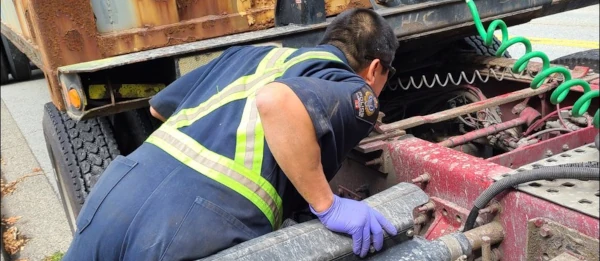 Many people think of traffic policing consists mostly of handing out speeding tickets. This is not the case as there are many other job functions that officers are responsible for. One that I often found to be an interesting challenge was conducting roadside mechanical inspections.
Many people think of traffic policing consists mostly of handing out speeding tickets. This is not the case as there are many other job functions that officers are responsible for. One that I often found to be an interesting challenge was conducting roadside mechanical inspections.

What Triggers Mechanical Inspections?
Inspections were frequently triggered by seeing something amiss after stopping a driver for a traffic rule violation, but occasionally police will set up a check stop dedicated to mechanical inspection. Triage will be conducted by a point person on the highway and suspect vehicles will be directed to the roadside for more thorough examinations.
Authority to Conduct Mechanical Inspections
In either case, the authority to conduct these inspections comes from the Motor Vehicle Act:
219 (2) A peace officer
(a) may require a person who carries on the business of renting vehicles or who is the owner or person in charge of a vehicle
(i) to allow the peace officer to inspect a vehicle offered by the person for rental or owned by or in charge of the person, or
(ii) to move a vehicle described in subparagraph (i) to a place designated by the peace officer and to allow the vehicle to be inspected there by the peace officer, or, at the expense of the person required, to present the vehicle for inspection by a person authorized under section 217, and
A systematic check of the vehicle is done and defects, if any, are identified.
CVSA Out of Service Criteria as a Guide
The enforcement action taken depends on the severity of the defect. I often chose to be guided by the Commercial Vehicle Safety Alliance's Out of Service Criteria set for North American commercial vehicles. If it was fair to take a commercial truck off the road, it was fair to apply the same standard to light vehicles as well.
Severe Defects
The most severe defects are dealt with by issuing a #1 Notice & Order, seizing vehicle licence plates and registration and calling a tow truck. Examples of common problems that triggered this action include brake system failure, excessive steering linkage wear, frame corrosion or unsafe vehicle modifications.
Significant Defects
A #2 Notice & Order was used when significant defects or a general pattern of neglect was uncovered. While concerning, the defects were not significant enough to justify the vehicle's immediate removal from the highway. The order gives the vehicles' owner 30 days to correct problems.
Both of these inspection orders require that the vehicle be taken to a Designated Inspection Facility, undergo a complete inspection and be repaired to the point that a pass could be issued.
Superintendent's Standards
Designated Inspection Facilities use the Vehicle Inspection Manual as the standard for repair.
Minor Defects
For minor items, a #3 Notice & Order is issued. The driver or vehicle owner is asked to make the listed repair and present the vehicle to show that the repair has been made.
Don't Ignore Notice & Orders
Ignoring these orders could result in significant consequences that include heavy fines and tow trucks.
Learn More
Share This Article
I be been thinking about another one of those things that have bothered me for a while and that is DRLs.
I recall when they were mandated and if I recall it was a Federal ruling.
I live on a dark island that has lots of tree lined major and minor roads that are narrow and winding and I constantly run across vehicles without DRLs. I like the idea of being visible and I’m confused by other driver/owners who seem to blatantly ignore what I think is their responsibly to ensure theirs are working.
So your this article inspired me to respond with my concerns. I know it is a minor infraction compared to others that can precipitate immediate stopping and actions but I believe this is where (a dark island or other rural road) they can help eliminate accidents and where it is imperative drivers are both visible to others on the road.
I suspect it’s very low on a traffic officer’s priorities when there are so many more threatening and important items to check.
- Log in to post comments
I have seen these inspections set up along the lines of commercial vehicle inspections. Gone through a few and most of the time they check tire wear, brakes, cracked windshields.
Have no problems with these yet one of my biggest complaints regarding DRL's never seem to be included. Of course this also goes with issuing tickets for other infractions such as not wearing seatbelts, cell phones. If you are stopping a vehicle for no seatbelts or cell phone use why not issue a ticket for disconnected or non-operational DRL while you have the vehicle stopped.
Most unusual stop I have ever had was being pulled over on the Trans Canada near Medicine Hat during a snow storm and told that my rear licence plate was obscured. She then proceeded to clean the snow off and sent me on my way. Only thing I have ever been able to come up with for that stop they had to be looking for a vehicle that matched mine.
- Log in to post comments
- Log in to post comments

Submitted by E-Mail